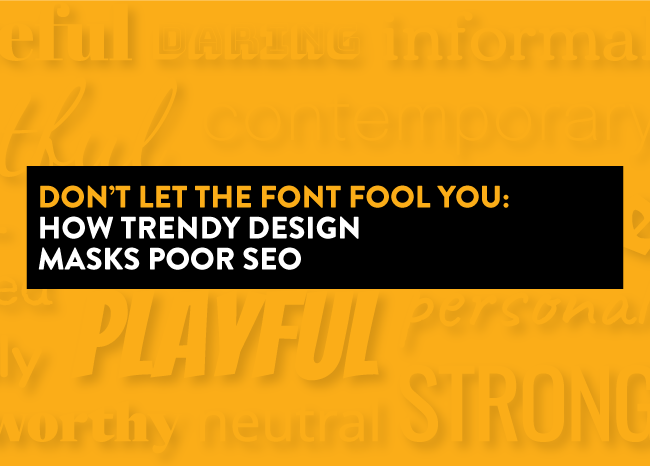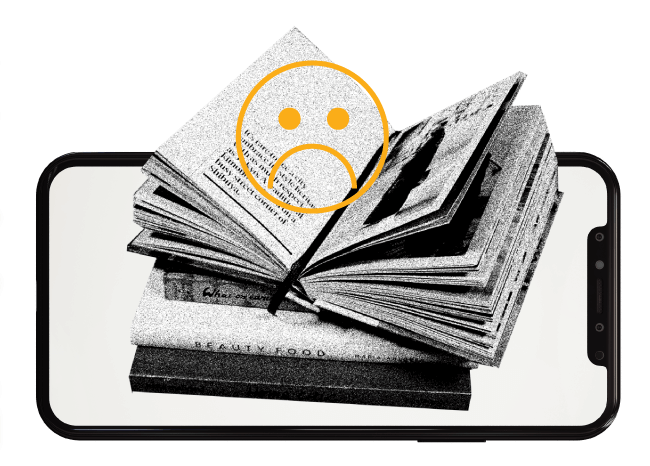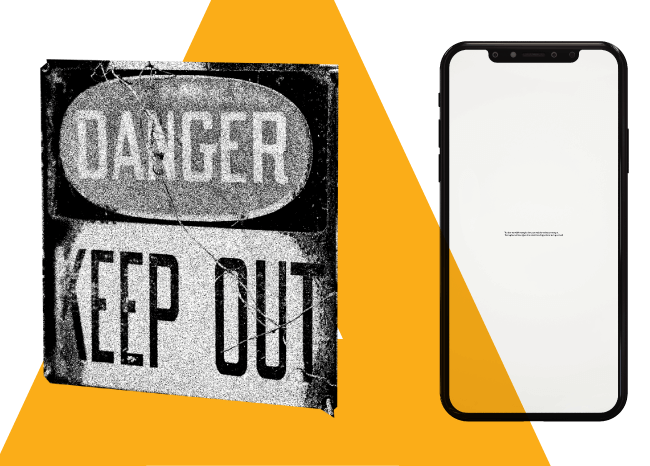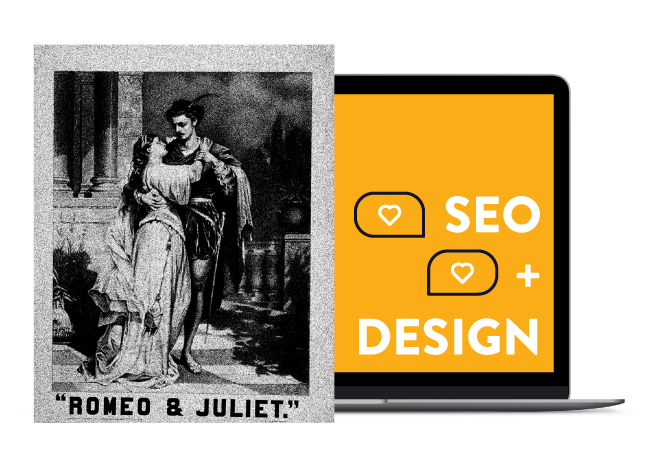Don't Be Fooled by the Font: How Trendy Design Masks Poor SEO
 According to Google Fonts download analytics, Roboto, Merriweather, and Lobster are the three most popular fonts used in blogging. While this may seem like an unnecessary tidbit, understanding current blogging trends — including the haps in SEO and web design — is pertinent.
According to Google Fonts download analytics, Roboto, Merriweather, and Lobster are the three most popular fonts used in blogging. While this may seem like an unnecessary tidbit, understanding current blogging trends — including the haps in SEO and web design — is pertinent.
It’s safe to assume that most content marketing professionals agree that aesthetics are important in web design. Not only does content design affect UX, but it affects site navigation, too.
As a web designer and/or business owner, you may already have a baseline understanding of what you should or shouldn’t do in regard to web design. However, it may be news to hear that the web design trends you think are helping are actually hurting your website and overall SEO.
Let me explain further how your site’s success relies on more than trendy designs.
Publishing Pretty Pages Won’t Cut It — Here’s Why
 Whether it’s an outsourced professional or the company owner, whoever’s in charge of web design should create an aesthetic yet functional site. Sure you’re able to attract users to your page, but if they can’t navigate it, then there’s no sense in aesthetics.
Whether it’s an outsourced professional or the company owner, whoever’s in charge of web design should create an aesthetic yet functional site. Sure you’re able to attract users to your page, but if they can’t navigate it, then there’s no sense in aesthetics.
Difficult page navigation can lead to users losing interest in your content and, therefore, finding it less helpful — staying on your site for less time. This leads to a series of unfortunate events like your site losing authoritative value, which then affects page rankings down the line.
You must draw your target audience to your page and maintain their interest by offering exactly what it is they’re looking for and ensuring they can get to it. Some web designers have been distracted by the idea that, as long as they follow current design trends, the reader will have a good experience.
When really, this couldn’t be further from the truth. Ultimately, what it comes down to is that implementing both a well throughout web design and basic SEO practices is necessary for overall success. Ask yourself whether or not the design trends you’re considering following are functional. If so, consider whether or not they’d be beneficial to include on your site.
Additionally, you’ll need relevant content published beyond your homepage — like a blog or FAQ page — to answer additional searcher queries that may arise. Basically, I’m saying that yes, your website needs to look good, but it should also have good information. Relevancy is important because it helps increase your expertise, authoritativeness, and trustworthiness (E-A-T) which is beneficial for your SEO.
One rising trend to note is the use of multimedia in more blog posts. In an article on web design and site functionality, UX Planet writer Servando Sanchez explains how image-led media platforms, like social media, continue to grow in popularity.
There are many reasons to explain the rising trends of using these platforms. One reason, to put it simply, is that they can be fun to look at. With that being said, I’m going to note (once again) that it’s crucial you use multimedia as a tool alongside other crucial elements of web design to help enhance user experience.
Sanchez continues to explain how there are pros and cons to having both an aesthetic and functional website. For instance, prioritizing both aesthetics and functionality may:
- Attract an audience to your site;
- Show off your marketing skills;
- Improve conversion rates;
- Create a more mobile-friendly design.
Make it a point to carve out time in your day to freshen up on current web design trends.
The Dangers of Chasing Web Design Trends
 The criteria for a trendy website are always changing. Just because Roboto is hot one year doesn’t mean it will be the next. This is just one reason why you should design to the beat of your own drum more often.
The criteria for a trendy website are always changing. Just because Roboto is hot one year doesn’t mean it will be the next. This is just one reason why you should design to the beat of your own drum more often.
There are trends to avoid regardless of when they’re hot or not. In fact, one design aspect you should be the most mindful of is font. While it may seem like common sense, you should refrain from using illegible text anywhere on your website.
This includes:
- Large text blocks;
- Using hard-to-read colors;
- Implementing fonts that are too big or too small to read.
Not only are the above aesthetically unappealing, but they’re really not too functional. It may just be me, but I feel as if it’s common sense to not forgo difficult-to-see designs. Not to mention, including the above elements defies the laws of website accessibility.
Web accessibility means that “websites, tools, and technologies are designed and developed so that people with disabilities can use them.” Including illegible font isn’t the only thing that damages a site's accessibility. Embedding multimedia that’s too small/large, using bright or dull colors, or not using sound effectively could negatively impact web accessibility as well.
Making your website accessible for every user is important for many reasons. One of which is that it ensures every user, no matter their ability, has an equally satisfying experience combing your website. So as you can see, following some trends just because they’re trending doesn’t always guarantee a good user experience (UX). You must remember the basics of web and content creation, including accessibility, and how this will affect your audience.
SEO and Web Design: The Virtual Romeo and Juliet
 I’m sure you’ve heard of the classic tale of Romeo Montague and Juliet Capulet. The story of Romeo and Juliet entails a young couple willing to do whatever it takes to be together, despite the ongoing rivalry between the Montagues and Capulets.
I’m sure you’ve heard of the classic tale of Romeo Montague and Juliet Capulet. The story of Romeo and Juliet entails a young couple willing to do whatever it takes to be together, despite the ongoing rivalry between the Montagues and Capulets.
Now, imagine SEO as Romeo and web design as Juliet. When paired together, the two can be a great force to be reckoned with. And just like Romeo and Juliet, SEO and web design have unique characteristics that make their relationship, well, interesting.
Romeo and SEO
For instance, Romeo has one thing in mind — love. Romeo is an intelligent young man, but he can get too wrapped up in the idea of love that he loses all sense of logic on how to get it.
While his dedication to Juliet is admirable, it doesn’t benefit him the way he thought it would in the long run. Similarly, SEO has a primary goal in mind — to rank high on the search engine results pages (SERPs). If you apply SEO tactics all willy-nilly, like Romeo going about earning the Capulet’s trust, you may accidentally engage in black hat SEO.
Opposite of white hat SEO, black hat SEO practices manipulate Google web crawlers or “bots” in an attempt to increase page rankings, without necessarily offering the best, most accurate information or designing for the best UX. Instead of listening to his heart, Romeo should’ve listened to his head and analyzed the fact of the matter — impulse decisions will not win you love in the end. The same goes with implementing SEO — impulse decisions will not put your site at the top of the Google SERPs, and failure to keep both your competition and your users in mind may end up setting you back.
Juliet and Web Design
Don’t worry, I didn’t forget about Juliet’s role in their unfortunate fate. While Romeo did whatever it took to earn his one true love, Juliet was naive enough to fall for his every tactic.
When thinking of web design as Juliet, it’s important to consider how implementing every new trend can be a rookie mistake like the one she made while listening to Romeo.
This is because, of course, when a new design trend is, well, new, it can also be naive to the realities of the UX. Establishing a website with all styles and no substance could cause a domino effect, causing you to do something more drastic to your website that won’t necessarily get you the intended results you were hoping for.
Like with 13-year-old Juliet, it doesn’t take much as a website creator to be persuaded into following the advice of what appears to be someone who’s been around longer and, therefore, should be wiser — cue in Romeo, a.k.a., SEO.
Poor SEO Examples
 Yes, web design is important. However, if you implement poor SEO practices, whether intentionally or not, then web design takes a backseat. At that point, you’re just masking your mistakes rather than repairing them.
Yes, web design is important. However, if you implement poor SEO practices, whether intentionally or not, then web design takes a backseat. At that point, you’re just masking your mistakes rather than repairing them.
There are SEO tactics to avoid at all costs. Disregarding the following practices could damage the authority of your site, which can ultimately impact your company’s well-being.
These particular practices, referred to as the seven deadly sins of SEO, are:
- Procuring spammy backlinks;
- Not fully understanding searcher intent;
- Disregarding the growing need for the ultimate UX;
- Over-optimizing your content for algorithms instead of users;
- Only measuring success by traffic;
- Publishing lackluster content;
- Failing to fact-check and copy-edit your content.
This is when investing in professional SEO practices, like link building and SEO auditing services comes in handy. SEO experts can curate content specific to your website and target KPIs — whether it’s keyword-focused content or content worthy of earning links — to ensure the content is compatible with best SEO practices and quality site design.
Poor Web Design Examples
 Aside from avoiding illegible fonts, you should also avoid:
Aside from avoiding illegible fonts, you should also avoid:
- Poor, inaccessible color palettes including, but not limited to poorly contrasted color schemes;
- Little to no responsive design;
- Slow page speed;
- Busy, overwhelming design elements.
I can’t tell you what to do with your web design, but I can make a few suggestions on what to refrain from doing. It’s up to you to decide whether or not you’re using the right font or just giving in to the trends.

